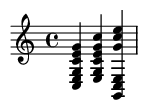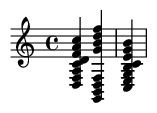Summary:
Chords are the fundamental building blocks of harmony in Western music. This comprehensive guide explores chord construction, types, functions, and applications across musical genres. From basic triads to complex extended harmonies, understanding chords opens up endless possibilities for composition, improvisation, and musical analysis. The article covers theoretical concepts while providing practical examples and exercises for musicians at all levels.
Keywords:
Musical chords, triads, seventh chords, extended chords, altered chords, chord voicings, chord progressions, harmony, chord inversions, chord functions.
Introduction:
Chords form the harmonic foundation of Western music, providing the rich tapestry of sounds that support melodies and create emotional depth. Whether you're listening to classical symphonies, jazz improvisations, rock anthems, or pop ballads, chords are the sonic structures that give music its vertical dimension.
At its core, a chord is a combination of three or more notes played simultaneously. But this simple definition belies the extraordinary diversity and complexity of chords in practice. From the bright, happy sound of a major triad to the tense, unresolved feeling of a diminished seventh, chords come in countless varieties, each with its unique sound color and emotional quality.
This article explores the fascinating world of chords—their construction, classification, function, and application. Whether you're a beginner seeking to understand the basics or an experienced musician looking to expand your harmonic vocabulary, this guide will deepen your appreciation of these essential musical building blocks.
The Building Blocks of Chords
Intervals: The DNA of Chords
Before we can build chords, we must understand their ingredients: intervals. An interval is simply the distance between two notes. Chords are built by stacking specific intervals on top of a starting note, called the root.
- Minor second (m2): 1 semitone (e.g., C to Db)
- Major second (M2): 2 semitones (e.g., C to D)
- Minor third (m3): 3 semitones (e.g., C to Eb)
- Major third (M3): 4 semitones (e.g., C to E)
- Perfect fourth (P4): 5 semitones (e.g., C to F)
- Tritone (TT or aug4/dim5): 6 semitones (e.g., C to F#)
- Perfect fifth (P5): 7 semitones (e.g., C to G)
- Minor sixth (m6): 8 semitones (e.g., C to Ab)
- Major sixth (M6): 9 semitones (e.g., C to A)
- Minor seventh (m7): 10 semitones (e.g., C to Bb)
- Major seventh (M7): 11 semitones (e.g., C to B)
- Octave (P8): 12 semitones (e.g., C to C)
Scale Degrees and Roman Numerals
In tonal music, chords are built from the notes of a scale. Each note of the scale, or "scale degree," has a name and a function, often represented by a Roman numeral. Understanding these helps explain how chords create movement and resolution in a piece of music.
- I (Tonic): The 1st degree. The 'home' chord, providing a sense of rest and finality.
- ii (Supertonic): The 2nd degree. A pre-dominant chord that leads naturally to the Dominant.
- iii (Mediant): The 3rd degree. Shares notes with the Tonic and can function as a weak Tonic substitute.
- IV (Subdominant): The 4th degree. A pre-dominant chord that creates moderate tension and moves away from the Tonic.
- V (Dominant): The 5th degree. Creates strong tension and has a powerful pull back to the Tonic.
- vi (Submediant): The 6th degree. The relative minor, often used as a gentler Tonic substitute or a pivot to other keys.
- vii° (Leading Tone): The 7th degree. A highly unstable chord that strongly leads to the Tonic.
Basic Chord Types
Triads: The Three-Note Foundation
Triads are the most common chords, built by stacking two third intervals above a root. There are four basic types of triads, each with a distinct emotional character.
- Major Triad (M): Root + Major Third + Perfect Fifth (e.g., C-E-G). Sounds bright and stable.
- Minor Triad (m): Root + Minor Third + Perfect Fifth (e.g., C-Eb-G). Sounds somber or reflective.
- Diminished Triad (°): Root + Minor Third + Diminished Fifth (e.g., C-Eb-Gb). Sounds tense and unstable.
- Augmented Triad (+): Root + Major Third + Augmented Fifth (e.g., C-E-G#). Sounds mysterious and unsettled.

Diatonic Triads
When you build a triad on each degree of a major scale, you get a predictable pattern of chord qualities. In any major key, the pattern is: Major, minor, minor, Major, Major, minor, diminished.
C Major Scale Diatonic Triads:
- I: C Major (C-E-G)
- ii: D minor (D-F-A)
- iii: E minor (E-G-B)
- IV: F Major (F-A-C)
- V: G Major (G-B-D)
- vi: A minor (A-C-E)
- vii°: B diminished (B-D-F)
Seventh Chords: Four-Note Extensions
Adding another third on top of a triad creates a seventh chord. These four-note chords are richer and more complex, forming the harmonic backbone of genres like jazz and R&B.
- Major Seventh (maj7): Major Triad + Major Seventh (C-E-G-B)
- Dominant Seventh (7): Major Triad + Minor Seventh (C-E-G-Bb)
- Minor Seventh (m7): Minor Triad + Minor Seventh (C-Eb-G-Bb)
- Half-Diminished Seventh (ø7 or m7b5): Diminished Triad + Minor Seventh (C-Eb-Gb-Bb)
- Fully Diminished Seventh (°7): Diminished Triad + Diminished Seventh (C-Eb-Gb-Bbb)
- Minor-Major Seventh (m(maj7)): Minor Triad + Major Seventh (C-Eb-G-B)

Chord Voicing and Inversions
The way a chord's notes are arranged is called its voicing. One of the most fundamental ways to change a chord's voicing is through inversions. An inversion changes which note of the chord is in the bass (the lowest-sounding note) .
- Root Position: The root of the chord is the lowest note. (e.g., C-E-G)
- First Inversion: The third of the chord is the lowest note. (e.g., E-G-C)
- Second Inversion: The fifth of the chord is the lowest note. (e.g., G-C-E)
Inversions give a different flavor to the same chord and help create smooth basslines between chords.

Chord Progressions: The Narrative of Music
Chords rarely exist in isolation. They are typically arranged in sequences called chord progressions. These progressions create the story of a piece of music, building and releasing tension to guide the listener on an emotional journey. This is governed by the principle of functional harmony.
Common Chord Progressions
While countless progressions exist, a few have become the foundation for thousands of songs across many genres.
The Foundational Progression: I - IV - V - I
Used in everything from classical to folk to blues, this progression establishes the key, moves away from it, creates maximum tension, and resolves satisfyingly back home. In C Major: C - F - G - C.
The Pop Standard: I - V - vi - IV
You have heard this progression in countless pop hits from the last several decades. It's emotionally potent and cycles endlessly. In C Major: C - G - Am - F.
The Jazz Workhorse: ii - V - I
This is the most important progression in jazz. The ii (pre-dominant)
sets up the V (dominant), which then resolves to the I (tonic). It is the engine of jazz harmony. In C Major: Dm7 - G7 - Cmaj7.

Beyond the Basics: Extended, Suspended, and Altered Chords
Once you master triads and seventh chords, a whole new world of harmony opens up.
- Extended Chords: By continuing to stack thirds on top of a seventh chord, you get 9th, 11th, and 13th chords. These are common in jazz and funk, adding sophisticated color. A Cmaj9 chord, for instance, is C-E-G-B-D.
- Suspended Chords (sus) : A 'sus' chord replaces the third with either a perfect fourth (sus4) or a major second (sus2). This creates a feeling of gentle tension that 'longs' to resolve back to a standard major or minor chord.
- Altered Chords: Primarily used in jazz, altered chords are dominant seventh chords where the fifth and/or ninth are raised or lowered (e.g., a sharpened fifth, a flatted ninth). This creates intense dissonance that resolves dramatically.
Conclusion
Chords are the harmonic building blocks that give music its rich emotional palette. From simple triads to complex extended harmonies, from functional progressions to experimental clusters, chords provide the vertical dimension that supports and interacts with melody.
Understanding chord construction, inversions, and function empowers musicians to make informed creative choices, whether composing, arranging, improvising, or analyzing music. The principles outlined in this guide provide a solid foundation, but true mastery comes from practical application—playing chords, listening critically to how they're used, and experimenting with your own progressions.
As you continue your musical journey, remember that while theory provides a framework for understanding, the emotional impact of chords is ultimately what matters most. Trust your ears, explore freely, and use chords to express your unique musical voice.
References:
-
Piston, W. (1987). Harmony (5th ed.). W. W. Norton & Company.
-
Levine, M. (1995). The Jazz Theory Book. Sher Music Co.
-
Persichetti, V. (1961). Twentieth-Century Harmony: Creative Aspects and Practice. W. W. Norton & Company.
-
Schoenberg, A. (1983). Theory of Harmony (R. E. Carter, Trans.). University of California Press.
-
Mulholland, J., & Hojnacki, T. (2013). The Berklee Book of Jazz Harmony. Berklee Press.
